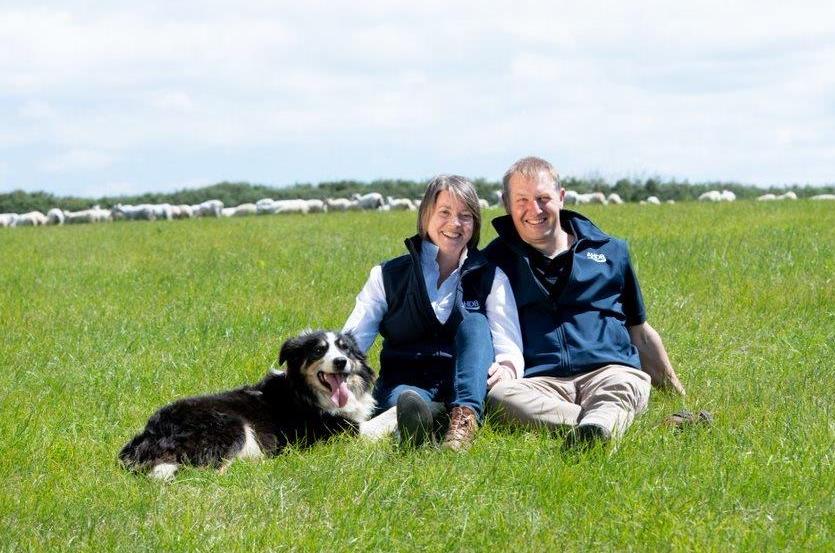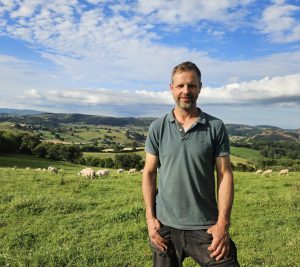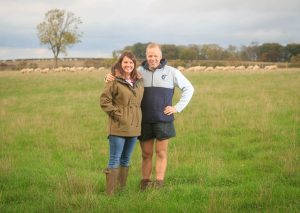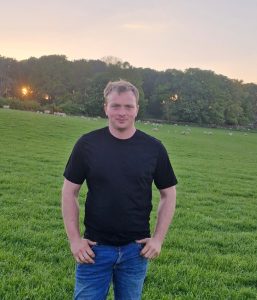with thanks to Rob and Liz Priest, Kingsford Farm, Holsworthy
Swapping a traditional flock for forage bred and reared genetics from Innovis has turned around Rob and Liz Priest’s sheep enterprise in the last decade. This enabling them to optimise output from their two low input grass-based organic units based on the Devon/ North Cornwall border and in turn towards maintaining a sustainable and profitable business.
“Our split lambing flock of Aberfields and Highlanders are leaving faster finishing lambs and we’ve also been able to reduce both fixed and variable costs, ease the workload and make labour savings as well as the grazing availability,” Rob explains indicating judicious decisions made 8 years ago reflect the power of maternal genetics.
“The Highlander ewes lamb outdoors from 20 March, they’re easy to lamb and this year despite the most atrocious weather they lambed themselves, the lambs were soon up and sucking, while the ewes had plenty of milk and they naturally take their lambs with them.
“While the Aberfield flock currently lambs indoors from 20 February, ewes receive minimum supplementary organic rolled oats mix during the two to three-week pre lambing period and are turned out usually 24 hours after birth. Ten years ago we wanted to make life easier and invested in a new lambing shed which has really made lambing in and handling ewes and lambs throughout the season much easier. Since we’re now successfully lambing the Highlanders outdoors and saving five tonnes of organic concentrate each season, we are definitely considering moving the Aberfields to lamb outside as well.”
In fact, this is one aspect of the unit where Rob regards further cost-cutting could be made. “Since the Aberfields are proving to offer similar maternal traits to the Highlander ewes, I think we could safely lamb them outdoors too and make similar concentrate savings, despite the fact we farm wet land we’d just need to make more paddocks available and make that leap of faith again,” he explains.
…we are confident to introduce one ram to 90 to 100 ewes, whilst ewe fertility is reflected in the fact the vast majority of ewes from both flocks lamb within the first cycle.
“Furthermore, we are confident to introduce one ram to 90 to 100 ewes, whilst ewe fertility is reflected in the fact the vast majority of ewes from both flocks lamb within the first cycle.”
The Priests bought the first Innovis genetics back in 2016. “Other ram breeds were demonstrating poor longevity, so we invested in the Primera terminal sire; despite his lambs not looking as big as our Suffolk and Texel crosses, they weighed significantly heavier. We then tried the Highlander and experienced the maternal benefits; finally independent sheep consultant, Lesley Stubbings endorsed Innovis and recommended the Aberfield at which point we were understanding the Innovis principles which fitted in with what we’re about.” At the time, the couple’s traditional Mule flock was coming to its natural end and they needed to buy in replacements, they invested in 100 Aberfield cross Welsh ewes for grading up the existing Mule flock and the rest is history.
“There are so many different breeds to choose from and you really don’t know until you buy and try,” says Rob. “However, we were initially attracted to Innovis genetics having learned they were forage bred and reared and they had an evidence base behind them of EBVs which I’m a great believer in,” he says adding: “I’m not a fan of the showring – it’s not for real,” indicating maternal traits are very difficult to predict by eye.
Primera cross lambs are finishing to 18 – 20kg target weight solely off milk and grass from 12 weeks…
Around the same time, the Priests agreed to transit from set stocking to rotational/paddock grazing. “The system is enabling us to make better use of our grass and in turn, livestock performance. Primera cross lambs are finishing to 18 – 20kg target weight solely off milk and grass from 12 weeks while the vast majority are away from grazed grass within the summer grazing months.”
Fields are divided by wire in to 2.5 acre paddocks. Ewes are introduced in groups of 15 to 20 per paddock at lambing to reduce the risk of mismothering. Towards the end of lambing, ewes and lambs are mobbed up and moved every three days in a system with eight paddocks. “The rotation takes 24 days, offering them the sweetest grass and preventing the need for recreational topping later in the year.”
He adds: “Whilst there’s no silver bullet to farming and we’ve found from experience changing a system doesn’t always work within the first year and sometimes second or third but we find we can continually tweak things to make them work really better, however we’ve discovered introducing Aberfield and Highlander ewes as a long-term investment which is certainly fitting our low input strategy and offering further potential to reduce inputs whilst stepping up output.”



